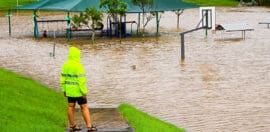How your workplace can be energy-efficient

27 June 2019 at 8:27 am
It has never been more important to get cracking on reducing emissions – wherever we work and whatever we do. Here, Greenpeace Australia Pacific CEO David Ritter offers some top tips on how to implement energy efficiency measures and install your own solar, as part of a series on Fighting Global Warming in your Workplace.
What if there was a massive national emergency? Something so serious that it threatened the future of Australia? Something like the spread of plague or the prospect of an attack by a hostile power like in World War Two? And what if the government of Australia in this time of great peril basically acted like the threat wasn’t real and came up with nothing but ineffective token measures, spin and lies? And then what if that government was re-elected?
I think you can see where I am heading with this.
Since the last in this series of articles for Pro Bono News, we’ve seen the re-election of the Morrison Coalition government – which went to the election without an effective set of policies for reducing Australia’s climate emissions or tackling coal, which is our number one driver of climate change.
But the national government is not the country. Huge amounts of climate action can occur outside of what the Commonwealth government does. Cities, towns, states, territories, businesses, institutions of all kinds can take action to reduce emissions – and compel political change.
As Liberal Senator Arthur Sinodinos said very clearly during the ABC’s election night coverage, community sentiment can compel political action on climate change. So it has never been more important to get cracking – wherever we work and whatever we do. We need decisive climate action in every workplace.
In the previous article in this series, I addressed the most practical question of how your workplace can make the shift to buying 100 per cent renewable power for your electricity needs. In this piece, I want to tackle the other half of the workplace clean power equation: how to implement energy efficiency measures and install your own solar.
Let’s start with energy efficiency – which is the ultimate win-win in terms of reducing the carbon emissions that are driving global warming.
In real practical terms, energy efficiency means focusing on things like heating, cooling, ventilation, lighting and appliances. Energy efficiency is literally about getting more from less – so that you pay less and pollute less. As the peak Energy Efficiency Council says: “Energy efficiency means increased productivity, lower energy and maintenance costs, increased competitiveness, improved amenity for staff and reduced exposure to fluctuating energy prices.”
The Energy Efficiency Council lists a bunch of providers, as well as a whole lot of learning opportunities. Some local councils (which are themselves now beginning to lead the charge in declaring the truth of the climate emergency) also provide energy efficiency information and resources. There’s also Renew, which is a national, not-for-profit organisation which can provide expert, independent advice and information on energy efficiency and other environmental footprint issues. There’s no shortage of information and resources – so no reason not to get on with becoming an energy efficient workplace as fast as possible.
So that’s buying 100 per cent clean energy and saving through energy efficiency… but how about your workplace actually becoming a producer of the good stuff – possibly even clean energy self-sufficient? For many workplaces, actually going solar is going to be a fantastic option.
When I checked in with community power expert Nicky Ison, she suggested a few good preliminary things to think about. Does the roof of your workplace catch much sun – because there’s no solar without it. If your workplace is in a heritage-listed building, then you will need to talk to your local council about guidelines from the get-go. And if your roof doesn’t have much space, then you won’t get much electricity out of a small solar array, so might need to look for other solutions.
Nicky also pointed me to SunSPoT which is an easy-to-use online tool for estimating the potential for electricity generation from solar panels on roofs in Australian cities. SunSPoT is one of those incredibly nifty 21st-century things; you can literally sit at your desk and check out any given site in an Australian city, taking into account solar radiation, weather, orientation, shading and other factors.
Once you’ve made your own inquiries, there are also great places to go for advice, too. The team at Renew, for example, offer a range of advice services, including on best options on solar installation. And again, your local council may also be another good source of information on how to go solar. Finally, if you can’t put down solar on your roof then get in touch with the Community Power Agency which can help advocate for solar solutions.
Together, we can do this – we can build a bridge through the storm of the climate emergency to a flourishing future for our families, communities, Australia and the world. And every workplace going 100 per cent clean energy can make a big contribution.
But one thing we know for sure is that technical solutions alone are not enough – more than anything it has been the politics that has held us back. Explaining how workplaces can play an incredibly important role in transforming the debate will be the subject of the next article in this series.
Thanks to Nicky Ison for information to enable the preparation of this article.
See also:








